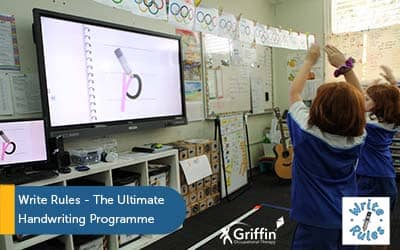Using the writing framework in reception
In July 2025, the Department for Education (DfE) released the writing framework guidance for England. This document, which will likely be updated when the curriculum review is finalised, provides guidance on how schools should support their students to be proficient writers. In this article, occupational therapist Kim Griffin will provide a quick summary of the document and let you know how Write Rules can support you to meet the recommended outcomes for reception students.
Key points: the writing framework in reception
1. The writing framework provides guidance on teaching transcription and composition – so both the physical part of handwriting and the thinking about and organising written work.
2. There are clear recommendations on teaching handwriting to reception students, including a focus on teaching printed letters in letter family groups, giving explicit handwriting instruction from the beginning of reception. The Write Rules handwriting scheme can support your school to implement these recommendations.
3. The writing framework advises whole body and fine motor skills should be incorporated into provision. GriffinOT’s membership provides staff with all of the tools they need to support this. Kim has completed the audit document here to show you how.
Using the writing framework in reception
In July 2025, the Department for Education (DfE) released the writing framework guidance for England. This document, which will likely be updated when the curriculum review is finalised, provides guidance on how schools should support their students to be proficient writers. In this article, occupational therapist Kim Griffin will provide a quick summary of the document and let you know how Write Rules can support you to meet the recommended outcomes for reception students.
Key points: the writing framework in reception
1. The writing framework provides guidance on teaching transcription and composition – so both the physical part of handwriting and the thinking about and organising written work.
2. There are clear recommendations on teaching handwriting to reception students, including a focus on teaching printed letters in letter family groups, giving explicit handwriting instruction from the beginning of reception. The Write Rules handwriting scheme can support your school to implement these recommendations.
3. The writing framework advises whole body and fine motor skills should be incorporated into provision. GriffinOT’s membership provides staff with all of the tools they need to support this. Kim has completed the audit documents here to show you how.

Implementing the reception writing framework in reception
The writing framework guidance provides clear guidance for teaching handwriting to reception students.
- It emphasises the importance of teaching handwriting regularly, explicitly, precisely and cumulatively from the beginning in reception.
- The reception writing framework recommends that there should be a clearly sequenced progression for reception student, such as the four letter family groups in Write Rules.
- It advises that handwriting lessons and practice should be in addition to phonics teaching and should begin at the start of the reception year.
- There is advice to include ‘ready to write’ routines within lessons – like Move with Jessie, Dough Dance, and the Crocodile Challenges included in GriffinOT’s Write Rules handwriting programme.
- It provides guidance on the choice of writing implement, the classroom set-up and adaptations for left-handed pupils.
- Each section includes an audit checklist, here’s how the Write Rules scheme of work can support you to meet the writing framework reception, handwriting and progression audits.
Practical suggestions in the reception writing framework
Key recommendations in the writing framework for reception classes are that handwriting should be:
- introduced through letter formation families and separately to phonics
- practiced daily, until pupils can write legibly and easily
- taught in small steps, with lots of opportunity for practice
- demonstrated by the teacher
- additional to any handwriting that forms part of teaching phonics
- practiced cumulatively with teachers building on what pupils have learned previously
- consolidated before teaching moves on so that pupils do not practise letters incorrectly
- revisited when further practice is needed
The reception writing framework also explicitly states that joined handwriting should not be taught until pupils can form these unjoined letters (print forms) correctly and consistently, exactly as Kim has recommended in the Write Rules programme.

What’s the difference between handwriting transcription and composition?
Transcription is the ability to write letters and words effectively. Transcription is the first step in being able to write, children need to know how to write their letters automatically to be efficient writers. They need to be able to write letters unconsciously, knowing the motor plans for letters without thinking. Write Rules helps them to learn transcription quickly and efficiently by teaching them letter their letter formations through movement and song. This audit helps you to see how Write Rules helps you to meet the standards within the writing framework in reception.
Transcription is different to composition, which refers to the ability to organise and structure pieces of written work. Such as writing sentences that are grammatically correct, organising these into paragraphs and structuring larger pieces of writing.
A focus on letter families with the reception writing framework
The reception writing framework chapter recommends that writing is taught in letter families. Letter families are a grouping of letters that are drawn with the same pattern. They differ from the order in which phonemes are introduced in a phonics programme. If you have never heard of the term, I’d recommend reading this article where I explain them.
According to the writing framework, ‘typical families’ (page 101) are:
- c o a g q d
- i l t k j
- v w u y f
- r n m h p b
- e s x z
As an occupational therapist, the groupings they suggest are very unusual! I am confused for the following reasons:
- Firstly, it confuses me why they suggest starting with curved rather than straight Developmentally, children learn to write straight lines before they can do curves.
- I am also highly confused why the letter k is included with i l t and j. The letter k includes diagonal lines, and getting the two smaller lines to connect is developmentally incredibly challenging. (The smaller lines in ‘k’ are technically half of a diamond, the average age children can do this is 7!).
- It also makes no sense to me why f, e and s would be put with letters that contain diagonal lines. For these reasons, I continue to recommend the letter families in Write Rules.
Recommended letter families
As a children’s occupational therapist, I recommended the Write Rules letter families groupings:
- l t I j u y
- r n m h b p
- c o a d g q f s e
- v w x z k
This is because, the Write Rules groupings start with developmentally appropriate straight, easy letters. Children progress to straight letters with a partial curve. Then, we adds in the more complicated curved letters. Right at the end, once the children have succeeded with easier letters, Write Rules adds in letters with diagonals. Developmentally this order makes sense. Supporting children to learn the easier letters first also gives them much more confidence! So, if the inspector asks, ‘Why you are not following the ’typical’ letter families in Appendix A?’, you can let them know that you are following letter families but starting with easier shapes first and keeping the most similar formation patterns together.
I will continue to recommend these family groupings as from a developmental and motor learning perspective, they make a lot more sense! The Write Rules songs provide a simple way to help your students to remember the rules as well.
The writing framework reception guidance recommends that schools implement a developmentally appropriate consistent approach to handwriting from Reception to Year 6. The guidance reinforces many of the tips Kim has been championing for many years and included in the Write Rules programme.
Next steps to implement the reception writing framework chapter
The reception writing framework chapter includes an audit to help your school with implementation Kim has completed the audit here, showing you how the Write Rules scheme of work can help you implement these successfully. Write Rules includes training for staff on fine and gross motor skills development and handwriting skills. The weekly lessons support reception and Year 1 teachers to teach handwriting in a progressive manner throughout the year. If you don’t already have a handwriting scheme of work, and are teaching letters in phonics groups, Write Rules will help you to easily switch to meet the writing framework guidance. Best of all, it’s included in the GriffinOT membership – so you not only have support for handwriting, but sensory needs and fine motor skills too.
Date last updated by Kim: 28th September 2025



